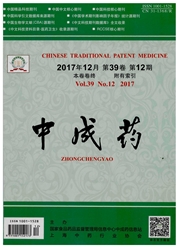

 中文摘要:
中文摘要:
目的通过观察平喘方(麻黄、苦杏仁、紫苏子、桃仁、莱菔子、黄芩等)对支气管哮喘模型小鼠肺组织中microRNA126与GATA-3表达的影响,阐释平喘方改善气道炎症的作用机制。方法采用10%鸡卵白蛋白腹腔注射致敏和5%卯自蛋白雾化吸入激发,建立BALB/c小鼠支气管哮喘模型。40只雄性BALB/c小鼠随机分为空白组、模型组、地寒米松组和平喘方组,每组10只,治疗4周后采集小鼠肺组织,用光学显微镜观察小鼠肺组织的病理学改变。用聚合酶链式反应测定肺组织中microRNA126与GATA-3mRNA的表达量。结果平喘方可以有效降低microRNA126,负向调控GATA-3的表达量,减轻支气管哮喘模型小鼠的症状,其作用与地塞米松组相当。结论平喘方对microR—NA126的干预可能是降低GATAd的一个切入点,从而达到抑制TH2过度表达,改善气道炎症。
 英文摘要:
英文摘要:
AIM To study the intervention role of Pingchuan Recipe ( Ephedrae Herba, Armeniacae Semen am- arum, Perillae Fructus, Persicae Semen, Raphani Semen, Scutellariae Radix, etc. ) on microRNA126 and GATA3 expression in mice's lung tissue of asthma model and the improvement in airway inflammation. METHODS In- jection of 10% ovalbumin and inhalation of 5% ovalbumin were used to establish the BALB/c mouse bronchial asthma model. Forty male BALB/c mice were randomly divided into control group, model group, dexamethasone group and Pingchuan Recipe group ( each with ten mice). For four weeks of treatment, the pathological changes of the lung tissue of mice were observed with an optical microscope. MicroRNA126 GATA3 mRNA expression levels in lung tissue were determined by polymerase chain reaction. RESULTS Pingchuan Recipe group could effective- ly reduce the level of microRNA126, reach the negative regulation of GATA-3 expression, and lessen the symptoms of mice with bronchial asthma equivalent to dexamethasone. CONCLUSION MicroRNA126 may be an access to reduction in GATA-3 and inhibition in the over-expression of TH2 to improve airway inflammation.
 同期刊论文项目
同期刊论文项目
 同项目期刊论文
同项目期刊论文
 期刊信息
期刊信息
